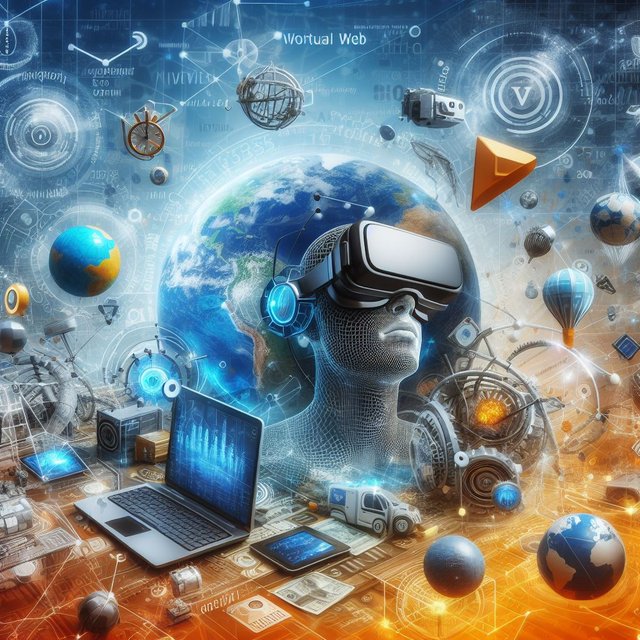Imagine a vast, interconnected realm where information morphs into experience, the physical and digital blend seamlessly, and boundaries between reality and illusion blur. This isn't the stuff of science fiction; it's the intersection of the internet, virtual reality (VR), and the World Wide Web, three potent forces reshaping our world in profound ways.
The Internet: The Scaffolding of a New Era
The internet, the invisible backbone of the digital age, acts as the foundation on which this intricate tapestry is woven. It's the invisible nervous system of our global society, transmitting information with the speed of light, connecting individuals across continents, and democratizing access to knowledge and communication like never before. The very existence of VR and the World Wide Web hinges on the robust infrastructure and protocols of the internet, making it the stage upon which these other technologies perform their magic.
The World Wide Web: A Canvas for Creation and Connection
The World Wide Web, a subset of the internet, lays the groundwork for information exchange and interaction. It's the web pages, hyperlinks, and multimedia elements that give the internet a human face. The Web allows us to build virtual communities, share stories, engage in commerce, and access a wealth of information beyond the wildest dreams of any pre-digital era. Think of it as the paint, brushes, and canvas on which we create, share, and explore the diverse landscape of the online world.
Virtual Reality: Stepping into the Illusion
VR, on the other hand, blurs the lines between perception and reality. It transports us into immersive, digitally generated environments, letting us experience worlds, characters, and situations that exist only in the realm of code. From exploring ancient civilizations to scaling Mount Everest, VR offers a portal to experiences that would otherwise be impossible. VR's capabilities extend beyond entertainment, finding applications in education, training, healthcare, and even therapy. Imagine practicing surgery in a simulated operating room or overcoming phobias in a controlled virtual environment. The possibilities are endless.
Intertwined Threads, Synergistic Potential:
The interplay between these three entities is where the true magic unfolds. The internet provides the infrastructure, the Web acts as the platform, and VR offers the immersive experience. Imagine learning about the Great Barrier Reef on the Web, then putting on a VR headset and diving into its vibrant coral gardens, surrounded by exotic marine life. Or think of attending a virtual concert with friends from across the globe, feeling the pulse of the music and the energy of the virtual crowd, even though you're all physically miles apart.
Shaping the Future: Challenges and Opportunities
This powerful convergence also presents challenges. Ethical concerns arise around user privacy, data security, and the potential for addiction in VR environments. The digital divide threatens to widen as access to VR technology remains uneven, potentially exacerbating existing inequalities. Furthermore, the blurring of lines between reality and illusion can have psychological and social ramifications, requiring careful consideration and thoughtful development of these technologies.
Despite these challenges, the potential of this dynamic trio is undeniable. Imagine collaborating on projects with colleagues across the globe in shared virtual workspaces, or attending educational tours of historical sites brought to life through VR. We can envision surgeons remotely performing complex procedures on patients in geographically remote areas, or students traveling to the depths of space without leaving their classrooms. The possibilities for education, communication, healthcare, and countless other fields are vast and transformative.
Navigating the Intertwined Maze:
As we venture further into this web-woven future, navigating the intersection of the internet, VR, and the Web demands responsible action. Developers must prioritize ethical considerations, user privacy, and accessibility. Governments need to develop regulations and frameworks that foster innovation while mitigating potential harm. Individuals must remain vigilant, aware of the limitations and vulnerabilities inherent in these technologies, and exercise critical thinking in their online and VR experiences.
Ultimately, the future of this convergence lies in our hands. By harnessing the combined power of the internet, the World Wide Web, and VR responsibly and creatively, we can build a future where reality and illusion interweave to create a world of unprecedented possibilities, a world where the impossible becomes a vibrant tapestry woven with the threads of technology, imagination, and human connection.
This is just a starting point. To delve deeper into this intricate interweaving, consider exploring the following:
Emerging trends in VR and its applications across various industries.
The ethical considerations surrounding data privacy, user agency, and the potential for virtual reality addiction.
The impact of these technologies on social interactions, education, and our collective understanding of reality.
The role of governments and individuals in shaping the responsible development and use of these powerful tools.
